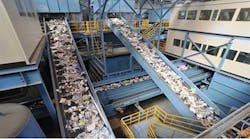Raw material reuse can be a profitable business model according to Mathy Stanislaus, EPA assistant administrator for the Office of Land and Emergency Management.
"Unsustainable raw materials use," Stanislaus told Barbara Grady of Green Biz, has made materials reuse "an imperative" for global economic players to address. About 40% of greenhouse gas emissions stem from how materials are managed.
Two automakers, GM and Ford, having adopted this concept, are very successful in implementing it.
GM
As reported by Grady:
GM, which churns out some 9.9 million cars a year, has such a sophisticated materials reuse program that 131 of its facilities produce zero waste. That includes 65 of its North American plants.
GM not only reuses its own metal pieces, worn tires and the packaging that arrives wrapped around supplies as source material in manufacturing new cars and trucks, but it is a major power behind the creation of the materials marketplace database whereby industries trade their used or surplus material resources. It's a project of the U.S. Business Council for Sustainable Development.
So, metal from GM's door stamp processes is found in heating and cooling products around the U.S. Its used battery covers are everything from garden planters to wildlife refuge habitats.
And GM makes $1 billion a year selling its already used materials.
Ford
Ford has been on a campaign to reduce its water and energy use and its carbon dioxide emissions while still growing earnings by 9% a year and growing revenues.
Here are some tactics the company is using, as reported by Grady.
In its 2012-2013 fiscal year, Ford saved $7 million just through switching lighting in its own operations to LED bulbs.
At the G7 meeting, Ford announced an effort to expand its environmental and resource conservation goals down its supply chain, unveiling what it calls its Partnership for a Cleaner Environment.
Working with 25 suppliers representing 800 manufacturing plants in 40 countries, Ford's Partnership will share with these suppliers what it considers best practices around reducing water, energy and carbon dioxide as well as materials reuse.
Mary Wroten, Ford's senior manager of supply chain sustainability who presented at the G7 meeting, said that by sharing what it has discovered works in-house with its legions of suppliers, Ford is able to multiply the reductions in water and energy use and GHG emissions.
“Climate is not a competitive space, and more that we can talk about this and share what we are doing, a stronger planet we can create,” Wroten said in an interview.
Its PACE program provides a software tool to suppliers, she said. With it, suppliers can set a target, say on water use reduction, and the tool offers potential practices from what Ford has found to be its best practices.



